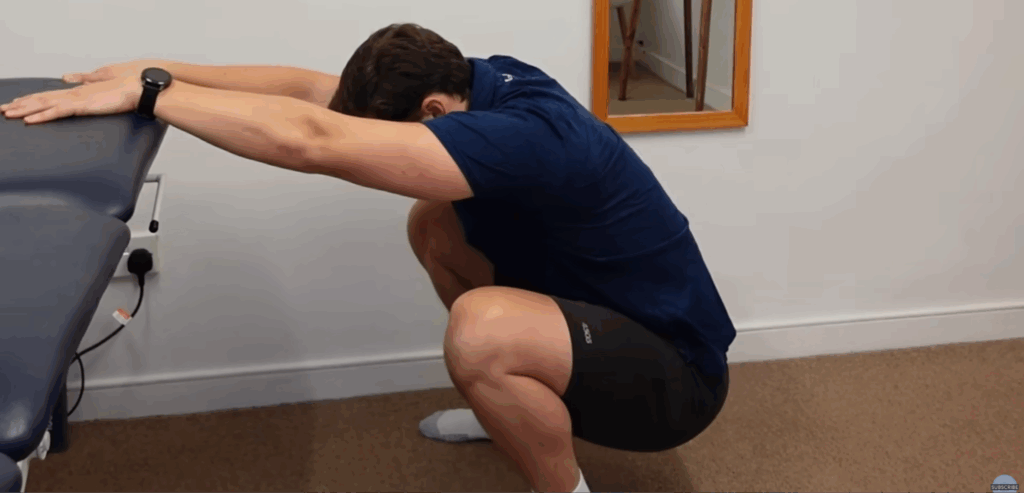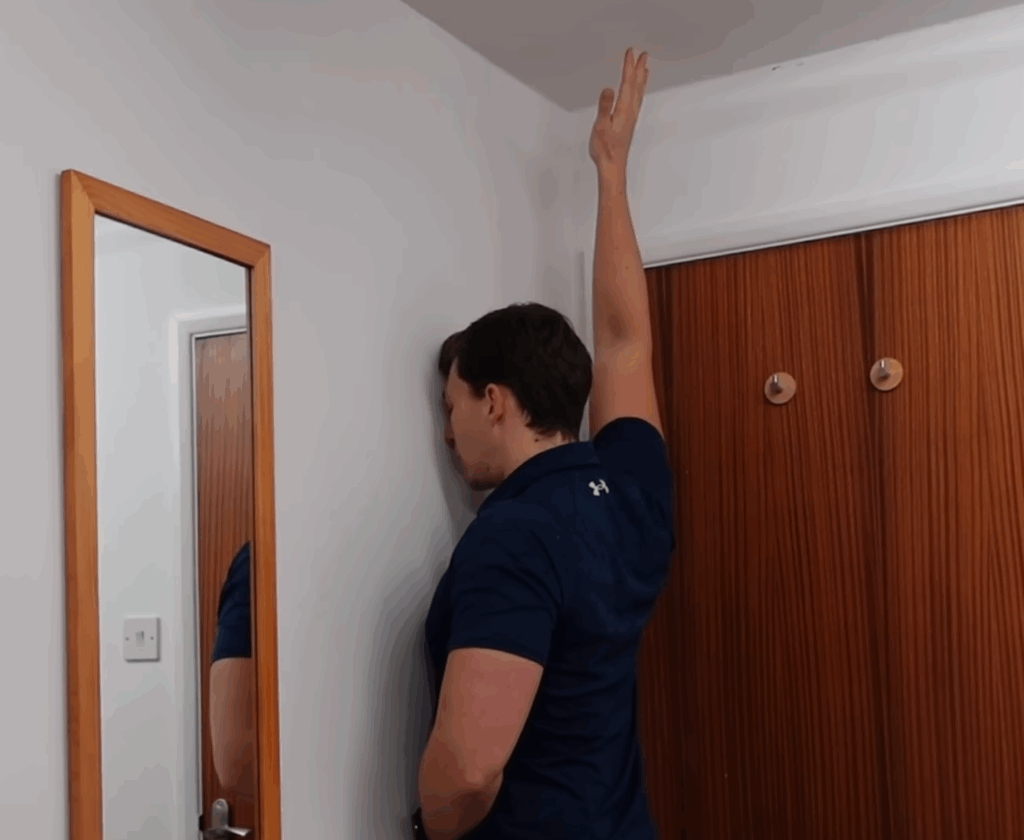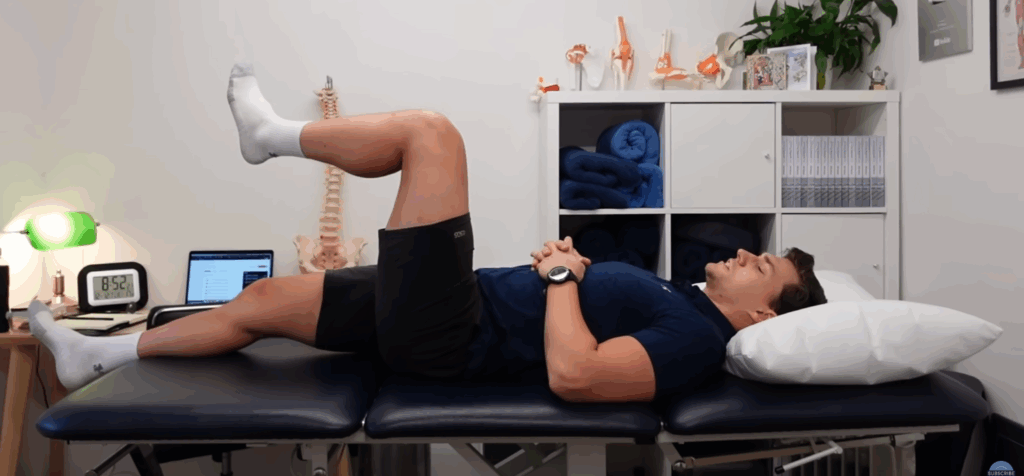If you’re over 50, there are three simple movements I recommend doing every day. They target the areas that most often become stiff, weak, or tight with age – hips, knees, ankles, shoulders, and the mid-back. A few minutes, twice a day, can make a real difference to how you move.
I’m Will Harlow, Over-50s Specialist Physiotherapist at HT Physio in Farnham. Below you’ll find the three movements, each with easy, intermediate, and advanced options so you can choose the level that fits your body today.
DISCLAIMER: The information in this post is not a substitute for individualized medical advice and the exercises are not suitable for every person. Please get checked out before you start any new exercise programme.
Movement 1: Sit-Back Squat
Why it matters: This is a “multi-benefit” pattern that helps you stay confident with chairs, stairs and everyday bending. Done well, it opens the hips and ankles, and maintains strength in the thighs and glutes.
Set-up: Stand facing a firm support – a kitchen worktop, sturdy chair back, or rail. Hold lightly with both hands.
Options
- Easy (Back-Friendly Lean):
Hold on, hinge your hips back slightly and let your torso lean forward just a touch. Soften the knees a little. You’ll feel a gentle stretch across the lower back and backs of the hips. Breathe. Return to standing. - Intermediate (Upright Squat):
Keep the chest open and back long. Sit your hips back first, then bend the knees so they track over your toes. Go to a comfortable depth (it might only be a few inches) and stand back up. - Advanced (Deep Sit-Back):
With hands on support, sit back as if reaching for a low chair, allowing the back to round slightly if comfortable. Explore the bottom position for a few breaths, then stand.

How much:
- 6–10 slow reps, 1–3 sets
- Or: “movement snacks” – 2–3 minutes of gentle reps while the kettle boils.
Coaching cues: Hips go back first, then knees bend. Heels stay grounded. If your knees are sore, reduce the depth and widen your stance slightly.
Movement 2: Overhead Reach
Why it matters: Shoulder flexion and a mobile mid-back make reaching cupboards, putting on a coat, and good posture much easier. Many people lose this movement over time – you can win it back.
Set-up: Stand facing a wall in good posture.
Options
- Easy (Wall Walk):
Place fingertips on the wall and walk your hand up until you feel a comfortable stretch. Pause 3–5 seconds, maybe lean your chest very gently towards the wall, then walk back down. Stay pain-free. - Intermediate (Higher Range Holds):
As your range improves, walk higher and hold for 10–20 seconds, breathing into any tightness around the chest and ribs. - Advanced (Nose-to-Wall Lift-Off):
Stand close so your nose lightly touches the wall. Keep gentle contact, squeeze your glutes for trunk stability, and lift your arm off the wall without your head coming away. Hold 2–3 seconds; lower with control. This builds end-range shoulder strength and thoracic control.

How much:
- 5–8 wall walks or lift-offs per side, 1–2 sets, 1–2×/day.
Coaching cues: Keep the neck relaxed, ribs stacked over pelvis, and avoid shrugging the shoulder up to the ear. You should feel this in the front of the shoulder/chest (stretch) and between the shoulder blades (control), not as a pinch.
Movement 3: Hip Rotation
Why it matters: Loss of hip rotation is often an early sign of hip trouble. Keeping rotation on both sides supports walking mechanics, turning, getting in/out of the car, and reduces compensation at the back and knees.
Set-up: Lie on your back on a firm surface.
How to do it
- Straighten one leg. Bend the other to 90° at the hip and knee so the thigh is vertical above the hip.
- Imagine the thigh bone is a pivot and gently rotate the shin across the body (internal rotation) until you reach a natural stop.
- Return to centre, then rotate the shin outwards (external rotation) the same way.
- Keep the thigh still – movement comes from deep in the hip joint.


Options
- Easy: Small, comfortable arcs with long, calm breathing.
- Intermediate: Increase the arc gradually; hold each endpoint for 3 seconds.
- Advanced: Add a light band around the feet for gentle resistance in each direction (only if pain-free and steady).
How much:
- 6–10 slow rotations each way, 1–3 sets per side, daily.
Normal findings: Many people are stiffer into internal rotation (shin across the body) – particularly men. Work more on the stiffer direction, but keep both.
How to Put This Into a Daily Routine
- Morning (2–5 mins):
Overhead Reach (wall walks), then Hip Rotation both sides. - Midday (2–3 mins):
Sit-Back Squats while the kettle boils. - Evening (3–5 mins):
Overhead Reach (lift-offs if ready), then a second round of Hip Rotation.
Consistency beats intensity. If you’re short on time, do one set of each every day – you’ll still notice changes within a few weeks.
Safety Notes
- Skip or modify anything that causes sharp pain. Mild stretch or muscular effort is fine; joint pain is not.
- If you have a history of shoulder impingement, avoid end-range pinch with the Overhead Reach – work lower and build slowly.
- With knee arthritis, keep Sit-Back Squats shallow, use a wider stance, and prioritise the hip hinge.
- Dizziness, pins and needles, or new joint swelling are signs to stop and seek advice.
If you’d like a personalised plan, we’d love to help at HT Physio (Farnham). And for more practical strategies, my book Thriving Beyond 50 is available on Amazon.
Author:
Will Harlow, MSc, MCSP – Over-50s Specialist Physiotherapist, HT Physio (Farnham, UK)
